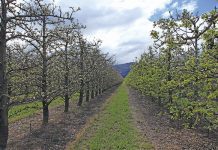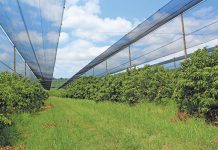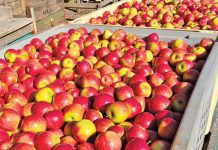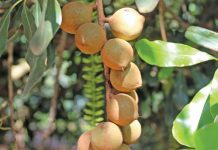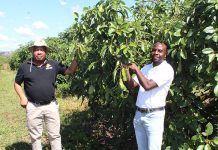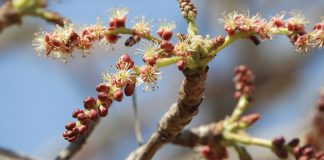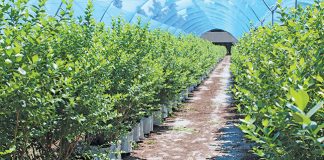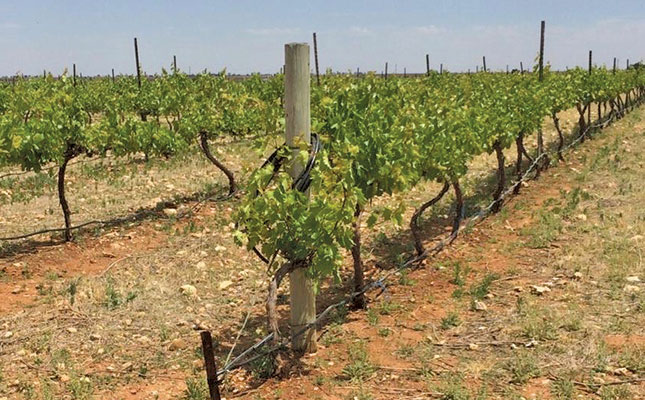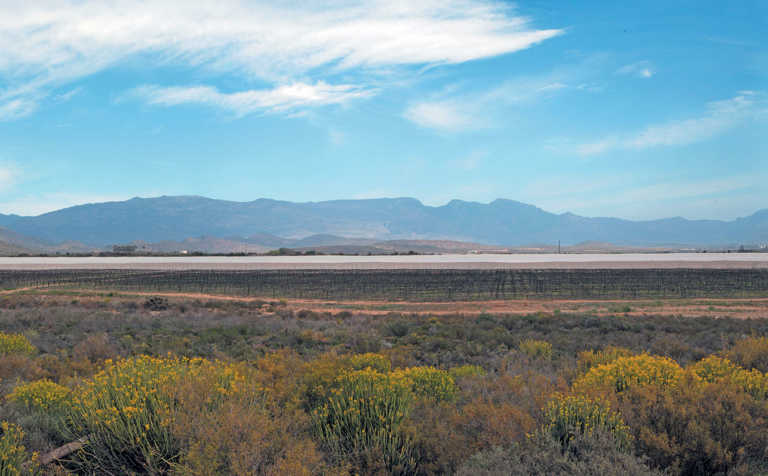
Photo: Glenneis Kriel
Increasingly, citrus producers from the Eastern Cape and other provinces are buying up land in the Western Cape, near villages such as Citrusdal and Robertson.
One of these is Hannes Joubert, owner of Habata, a major producer of citrus, cucurbits and vegetables in the Sundays River Valley, who bought a farm near Robertson in September 2015.
According to him, the move to this region enables farmers to spread production and climatic risks over a wide geographic area, as well as grow a greater variety of crops.
“The Western Cape is highly attractive because of its citrus black spot-free status, making it one of only a couple of regions in the country allowed to export citrus to the highly lucrative US market. The diversification has also reduced my market risks, by allowing me to incorporate new crops in my product range,” he explains.
Robertson, in the Breede River Valley, particularly appealed to Hannes because of the availability of labour during winter, when most of the wine grape and summer fruit production comes to a standstill.
Another drawcard was the fact that his son-in-law, Jan Rabie, could manage the farm on his behalf. Jan and his wife, Christie, farm near Nuy about 30km away.
“Starting a farming operation in another region is an expensive business and involves high risk,” says Hannes.
“I wouldn’t have risked it if I didn’t have someone capable, trustworthy and passionate about the enterprise to look after my interest.”
Hannes was no less attracted by the area’s affordability. While prices in the Sundays River Valley average between R400 000/ ha and R500 000/ ha, land under vines in the Robertson Valley is around R300 000/ha.
Economies of scale
Hannes had planned to buy a fairly small farm, but ended up purchasing Le Grand Chasseur at the foot of the Sandberg, 15km outside Robertson.
The 1 300ha property has 350ha of arable land, of which 330ha were under wine grape production when he bought the farm.
An application to expand by 350ha has been filed, pending the results of an environmental impact study.
“It made sense to buy Le Grand Chasseur, because economies of scale are so much better when you buy a large farm,” he says.
“It also solved the problem of future expansion. Neighbouring farms seldom reach the market, so expanding production from a smallish farm usually entails strange, often ineffective, logistics. With Le Grand Chasseur, there’s a lot of room for expansion in one location.”
Wine grapes
According to Jan, many people in the Western Cape are under the impression that new entrants to farming in the region are replacing wine grape vines with citrus trees. However, this is simply not true.
While he had removed 110ha of vines on Le Grand Chasseur, these had no longer been economically viable.
Moreover, average wine grape production had increased from 10t/ha before 2015 to 22t/ha in 2016, yet water consumption had decreased, from 6 000m³/ha to 4 500m³/ha.
Jan is convinced that he can reduce this figure even more, as he is currently achieving yields of about 30t/ ha on his own farm, near Nuy, using only 4 000m³/ha to 4 500m³/ha of water, depending on the cultivar produced.
He attributes the increase in production and improved water-use efficiency to better management practices.
“Instead of using a blanket fertiliser and irrigation programme, we adapted the programmes according to the requirements of different vineyards at different stages
of production.
For example, we take soil and leaf samples to determine nutritional shortages, and use continuous loggers and physically dig holes to monitor soil moisture levels. The same is done in our citrus and table grape orchards.”
Le Grand Chasseur came with its own cellar, where 3,8 million litres of wine can be produced from 5 000/t of wine grapes. The wine is sold to Constellation Brands, Distell and Origin Wine. These companies either bottle or sell the wine in bulk to various export destinations.
“The market for wine has been relatively flat for some time, but local demand is showing some improvement,” says Jan. “To me, wine grapes are like having a conservative investment portfolio: you’re not going to make a quick buck out of it, but the risks are lower than for a more aggressive growth portfolio.”
Shade nets
Removing the unviable vines has freed up 40ha for new wine grapes, which were planted this year. Additionally, 34ha of table grapes have been planted under shade nets, while 70ha of recently planted soft citrus will be placed under shade nets next year.
“The Robertson Valley is ideal for table grape production because of its low rainfall of roughly 250mm per year, but production never really took off because of the windy conditions. The use of shade nets as wind protection has made it possible to produce table grapes in regions where it might have been totally inconceivable a few years ago,” Jan explains.
Importantly, the nets are white. “With table grape production, you don’t want the vines to be shaded. You want them to get as much light as possible for optimal flower formation.
It’s therefore better to use white nets instead of coloured nets that might block out some light.”
The idea of producing table grapes was daunting at first, but Jan’s colleagues and family in the industry offered him advice and showed him their farming practices. His uncle, Anton Viljoen, a member of the Grape Alliance and owner of Denau Boerdery, is a leader in the table grape industry.
Jan has also relied on consultants for advice to ensure that he unlocks the full genetic potential of the cultivars planted.
“We’re pruning and feeding these vines to produce their first harvest 18 months after establishment and to produce a full commercial yield the year thereafter. The cultivars, including Crimson Seedless, Sweet Sapphire, Sweet Globe, Sweet Joy and Autumn Crisp, are generally high-yielding late varieties that will allow us to supply the market towards the tail-end of the season, when supplies start to taper off,” he explains.
While table grape returns are slightly lower than those of citrus, Jan sees it as a good diversification option. There is a healthy demand for table grapes, resulting in fairly good prices, and vines can be manipulated to produce grapes from their second year. Citrus trees take four years to produce commercial yields.
The establishment cost of wine grape vineyards and citrus is about R200 000/ha in each case, whereas it is about R450 000/ ha for table grapes under nets.
Establishing citrus under nets increases the cost to approximately R400 000/ ha. Only soft citrus cultivars, such as Tango, Clementine and Mandarin, have been planted. Hannes omitted lemons as he felt that the economic risks were high.
Water efficiency
According to Jan, there is a widely held misconception that planting citrus in Robertson significantly affects water resources and supply levels. He points out, however, that each farm has a specific water quota, and it is nearly impossible these days to increase this. In fact, farmers proactively seek to use water sparingly.
“We’re doing everything we can to use our water as efficiently as possible, starting with soil preparation and going on to the actual production of fruit.
“The soil is ripped 1,2m deep to allow the roots of the trees to grow deep in search of water and soil nutrients, and to prevent any layers from obstructing the movement of water,” he explains.
Orchards are partitioned according to soil analysis profiles. Thus, instead of irrigating the entire orchard to the same extent, and over- or under-supplying water in the process, farmers now supply each block with the appropriate volume.
Jan adds that citrus farmers employ only drip irrigation, which uses less than 50% of the water required by micro-sprinkler systems.
They also apply compost and mulch to improve the soil’s water-holding capacity, reduce water evaporation and keep the soil moist and cool. Moreover, water used to flush the irrigation system is recycled for later use.
Leveraging advantages
Jan plans to have nets erected over Le Grand Chasseur’s citrus orchards by spring next year.
“We’re currently putting up nets over the orchards in the Sundays River Valley. They greatly improve fruit quality, resulting in better pack-outs. They also help reduce the impact of climate fluctuations, with temperatures under the nets usually being milder than outside temperatures. So the nets help protect fruit from frost damage,” he explains.
On Habata in the Sundays River Valley, Hannes has 1 000ha under citrus production, and 700ha planted to cash crops such as butternuts, cabbage, seedless melons and watermelons.
His plan is to take maximum advantage of each growing area and seamlessly integrate both. Fruit produced on Le Grand Chasseur will be sold through the business’ existing channels, and his new Western Cape venture will open doors for produce from the Sundays River Valley.
To this end, a packing facility will be built on Le Grand Chasseur by 2020. Until then, fruit will be packed at other farmers’ facilities.
Phone Hannes Joubert on 042 230 1473.


